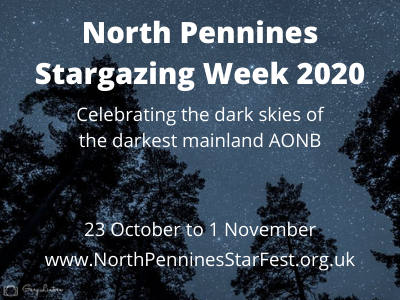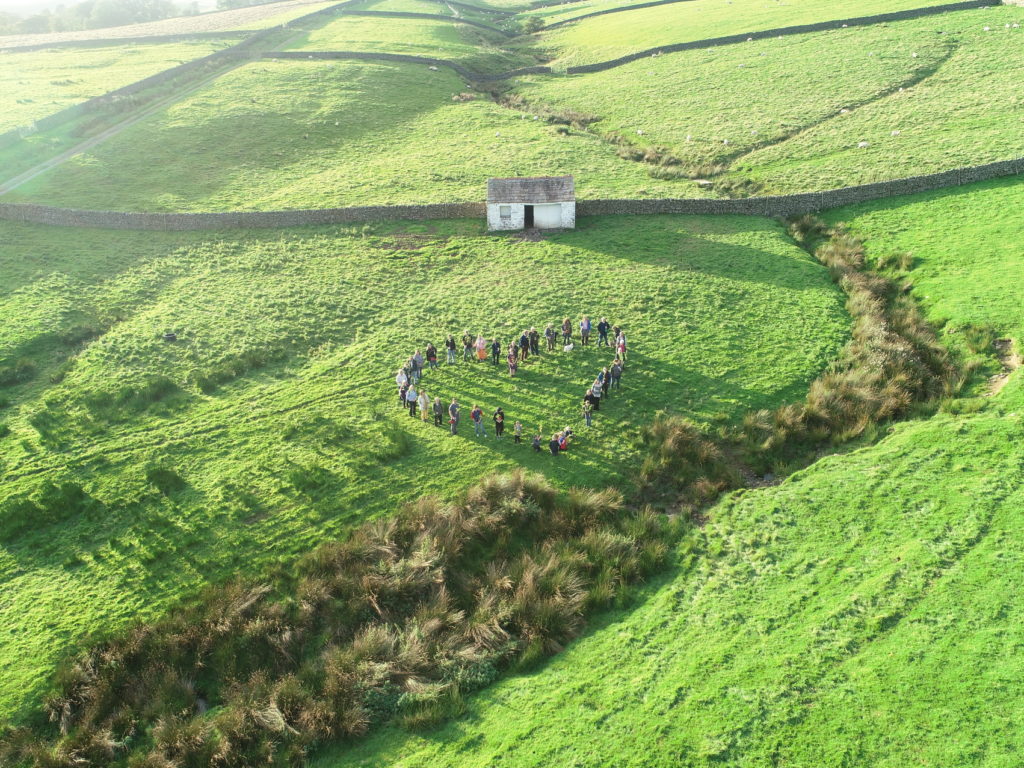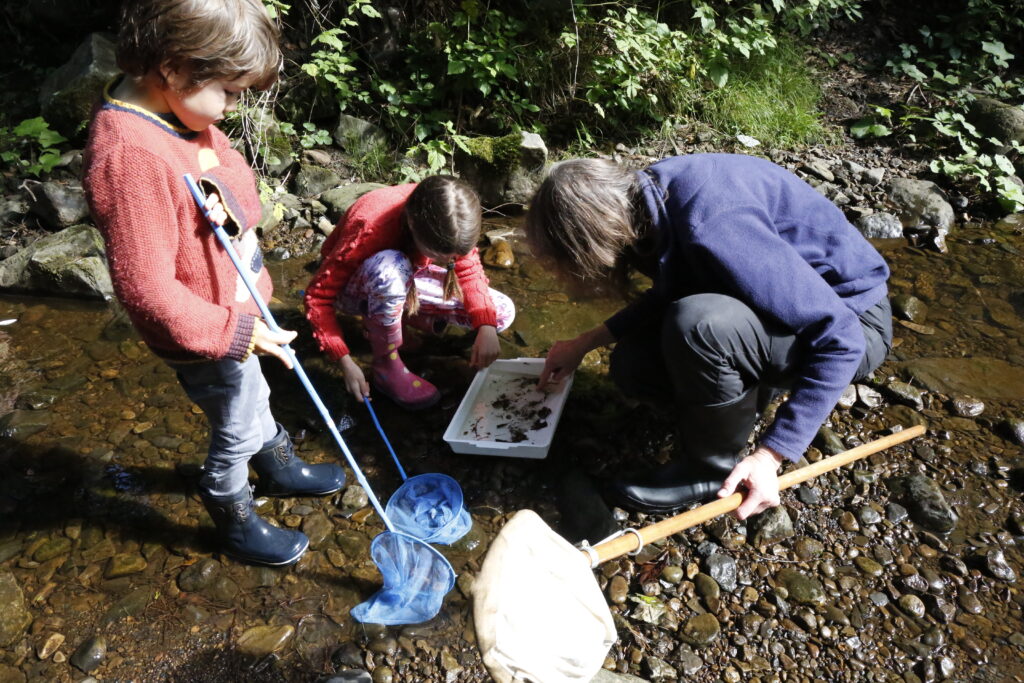North Pennines Stargazing Week
What can you see in the night sky?
5 December 2024
What can you see in the night sky?
By Roy Alexander, AstroVentures, Director of Learning and Lead Astronomer
North Pennines Stargazing Week 2020 is upon us and with a little know-how and some imagination you can quickly learn what to look for in the night sky.
Let’s go on an exciting journey across billions of miles, all from your garden, backyard or bedroom window.
To begin looking for heavenly objects, you’re going to need to know where North/South/East/West are, so download a free compass app to your phone, or note where sunrise (East) and sunset (West) are for you.
Next, download a free app onto your phone and one onto your computer as well. My favourite astronomy app for ease of use and features is, https://stellarium.org/ so download it now. Once it’s installed, set your location which means that it’ll show you what’s in the sky above you, wherever you live in the world. Once Stellarium is open it will automatically set to the exact time and date, but you can enter any date or time you like. You can also click on buttons to speed up the time and fast forward to the night-time and explore the sky from the comfort of your front room. Have a look at what was in the sky on the night you were born! Top Tip: make a list of things you want to search for in the sky at night and use Stellarium to find them virtually, so you know which direction they’re in, and how high up in the sky to look.
Quick tips
The Moon – during North Pennines Stargazing Week the Moon will be becoming full, and rising in the East, between 4 and 5pm.
The planets – Saturn and Jupiter are visible in the West just after sunset. Venus, shining brightly in the morning rises at about 4:30 am, and is easy to spot right up until sunrise.
The Pleiades Cluster – a group of young stars, naked eye visible, easily spotted after 8pm
The constellations – easy ones to find are the Plough, Cassiopeia, Orion.
Getting ready to stargaze
When you first turn off the lights your eyes will not work well in the dark because you have different cells in your eyes, some which work better during the day and others which work better at night.
During the daytime, or when your lights are on, the cells responsible for your ‘night vision’ are not really working at all. But as soon as it gets dark that starts to change. A chemical reaction in these ‘rod’ cells begins as soon as the lights are off, and it usually takes around half an hour for those changes to activate your ‘night vision’ fully. You can stargaze as soon as it is dark but be patient because you will find that your night vision improves over the following thirty to forty minutes. If you have smart lights, set them to red; you can keep dimmed red lights on without losing your night vision.
If you are stargazing inside looking through a window ensure your area is safe and free from clutter, turn off your lights and make yourself comfortable. If you have a yard or garden, turn off all the lights on that side of your house and turn off any outside lights too being careful to make sure your yard or garden is free from trip hazards before you do. Whether you live in the light-polluted city or are blessed with dark skies you are ready to start stargazing and the longer you leave the lights off, the better your night vision will become.
For your phone there are a couple of good, free apps to use when you start stargazing. I recommend Star Map for Android and Star Walk on iPhone. Both with tell you the names of stars, constellations, planets and so-on if you point your phone at the sky. Both have a night view or red light option which is useful once your eyes adjust to the dark.

Equipment
Much can be seen with the naked eye but if you are looking for some binoculars to buy, Sir Patrick Moore recommended 10×50 binoculars for astronomy. I have been using a set of 10×50 Helios Fieldmasters for years and they are robust and good value for money.
The Moon
The moon is usually only full once a month, or three times in a season but on 31 October there will be a second full moon for October. This means there are going to be four full moons this season so the full moon on the 31st is a ‘Blue Moon’. This does not happen very often hence the phrase ‘once in a blue moon’.
Looking at the Moon with your naked eyes you will notice dark and light grey patches. Light grey areas are mountainous highlands, and the dark grey areas are long dried-up volcanic seas. If you look closely you can see a white circle (where the seven would be if the Moon were a clock face) with rays of white pointing out from it. This is Tycho, a crater about as big as East Anglia!
If you have any kind of binoculars, whether they are old or even toy ones grab them and have a closer look at the Moon. You will see much more detail around the craters and seas but have a look around the edge of the moon and you will see it is not a perfect circle. The rough jagged outline is a because of lunar mountain ranges.
The phase of the Moon changes daily. The phase is how much of the moon is visible from Earth; full, half and crescent, for example. The line between the light and dark side of the Moon is called the terminator. Each night, if you look closely at the terminator, you will see different craters, valleys and mountain ranges as the line slowly moves across the surface.

The planets
In the morning, Venus is a bright dot in the East. Venus shines brightly due to reflecting sunlight towards us because it is shrouded in thick clouds. If you have got binoculars to hand, or a small telescope, you will notice Venus is not a perfect circle either – it has phases just like the Moon.
In the West after sunset throughout October, the planets Jupiter, Saturn, and Mars line up as three incredibly bright colourful dots. They are all visible with the naked eye, but if you have binoculars Mars will look salmon pink, Saturn appears oval shaped (because of the rings) and you might see some of Jupiter’s moons.
On 19 November at around 4:45pm, the Moon, Jupiter and Saturn are all remarkably close together in the sky, forming a conjunction, which is a rare event.
On 21 December there is a Great Conjunction of Jupiter and Saturn. They will be so close that to the naked eye you will hardly be able to tell them apart. In a telescope or binoculars, you will be able to view them together at the same time. This will only be visible from about 4:15pm to about 5:30 pm and you will need perfectly clear skies almost due South West. Great conjunctions only happen every 20 years so this is a once in a generation opportunity!
The constellations
Constellations are official patterns of stars. You will no doubt be familiar with some of the names and patterns. From now until Spring 2021 Orion will be visible in the sky, rising in the East at about 10pm in November. Very recognisable by the three stars in a row that form his belt, this is one of my personal favourites because hanging from his belt is a ‘sword’ containing another three stars and the middle ‘star’ is a naked-eye visible nebula where baby stars are being born! If you look at this with binoculars, you will be able to see a blurry smudge that some of you might see coloured turquoise.
Look North and you will see the Plough – often called the Big Dipper because it looks like a big drinking gourd. The second star on the ‘handle’ of the Plough is a naked eye double star. Look closely or use binoculars and you will be able to clearly see them even with high light pollution.
The International Space Station
Orbiting the Earth 250 miles high, is the International Space Station. Home to (usually) six astronauts from around the world, you can easily spot it with the naked eye flying from West to East. Go to https://spotthestation.nasa.gov/ and enter your location to see when it’s due to fly over you.
Shooting Stars
Shooting stars, also known as meteors, are small specks of space dust that burn up in the atmosphere. From Autumn to the first week of January the night sky is home to regular sporadic shooting stars, but there are also some well-known meteor showers. The best of these, known as the Geminids, occurs around 13 and 14 December. In recent years, this meteor shower has peaked across two nights, giving astronomers a better chance of spotting meteors whilst cloud dodging.
Webcams and online observing
Even when it’s cloudy you can explore the universe. Here are some useful links.
Aurora Borealis: https://liveauroranetwork.com/
ISS Live Stream: http://www.ustream.tv/channel/live-iss-stream+
Slooh do live streams and have a catalogue of older videos to watch on YouTube, and for a small fee you can take control of their remote telescopes: https://www.youtube.com/user/SloohOnAirVideos
Here’s a few links to some live all-sky cameras and telescopes. Some are more reliable than others.
This blog is part of the North Pennines Stargazing Week 2020. Visit our Stargazing Week hub for more events, blogs and features.












